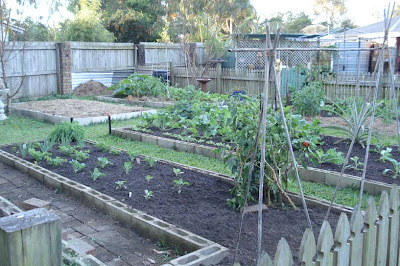Our vegetable garden is vitally important to us. It gives us the freshest organic food at minimal cost. To keep the cost of the garden down as much as possible, we make our own fertiliser, harvest rain water and save a lot of our own seeds. That has two advantages - it provides us with a closed system - reducing the risk of introducing weeds and disease from outside, and it increases our level of sustainability.

We have two big clumps of comfrey that grow all through the year. Comfrey makes a great fertiliser as it's chocka block full of nitrogen - the element that makes green leaves grow well. Comfrey tea is made by cutting half a bucket of comfrey leaves, putting a brick on them to keep them under water, then filling the bucket to the top with water. You need a lid for the bucket as this brew stinks to high heaven. Leave it for a week or so, then dilute a small amount of the brew with plain water till it
looks like weak tea. And that's your nitrogen fertiliser. This is perfect for plants like silverbeet (swiss chard), lettuce, cabbage, kale and all the leafy greens, but should be used sparingly on fruiting plants like tomatoes, capsicums and cucumbers. Putting too much nitrogen on fruiting plants will cause them to grow lots of green leaves and not so many tomatoes or cucumbers.
The fruiting plants are much better served with worm castings as it provides a rich fertile soil in which they will thrive. Read more about the benefits of microbes in the soil
here and
here. Microorganisms in your garden soil will increase your yield of fruit and vegetables. The simplest way to increase the level of microbes
is to add worm castings to your garden.
I have already written about
setting up a worm farm using an old bathtub, now I'll talk about harvesting the castings and maintaining the worm
farm.
From day one of your worm farm, when the catching bucket under the worm farm is full, you should pour that back into the farm. After about a week or so, you can start using the worm juice as fertiliser. The longer the worm farm goes for, the better the juice will be - beneficial bacteria and various microbes will built up in the juice and castings and will boost your crops when you apply it to the garden.
But let's get back to maintenance. Over the months you can scrape off castings from the top of the farm and use them on your plants. However, there will come a time, depending on how many worms you start off with, when it will be worth your while to rebuild the worm farm and harvest all the castings. In the photo below there are thousands of worms lurking. So how do I get them out of the castings so I can use it on the garden and keep the worms working in the farm? There are a few ways to do this, this is what I do.

I move all the castings over to one side of the bathtub. Use your hands, with gloves if you prefer, to move most of the castings - using a shovel or trowel will kill too many worms. Then, if you have weed mat or a microfibre filter under your castings, pick that up and roll the casts over. You will then have half the tub with only gravel under the filter material and half the tub full of castings and worms. Click on the photos to enlarge them.

Now start building up the empty side. You can do that the same as the instructions for building the worm farm, here I used shredded paper and completely composted horse manure. Before adding the next layer, I hosed this layer down to make sure it was completely wet. Remember though, you don't want your castings wet as the worms are in there and they don't like wet conditions - like like it moist, not wet.

My next layer was straw and any organic food I could find. Make do with what you have on hand. Here I have some old organic chook pellets that we decided were too old to be fed to the chooks and some green leaves picked from the garden. You're after variety here. The worms will eat everything you put in - the paper, manure, chook food and the leaves. Hose this layer to make sure it's completely wet.

Then I covered the new section with an old wet bathmat. The worms will eventually eat that too. I wanted to create a tasty attractive environment so that the worms would travel from the castings over to the new side.

I did this one week ago and when I checked yesterday the worms had already moved into the new food. I'll give it another week and then take all the castings out and use them on the garden. There's about 30 kgs of castings there - a huge boost for our vegetables and fruit. When that side is empty, I simply repeat the layering exercise, and the worms will eventually eat their way back to that side too.
If you've been thinking about starting a worm farm, jump right in. Even if you're in an apartment and want to do some composting, a small worm farm will use up all your kitchen scraps and give you great castings for your indoor plants. And don't worry about constant care. If you've given your worms a good feed and they're in moist conditions you can easily leave them for a week without feeding.






